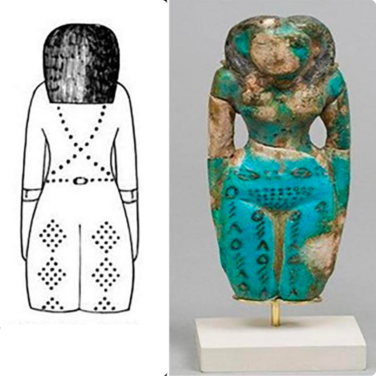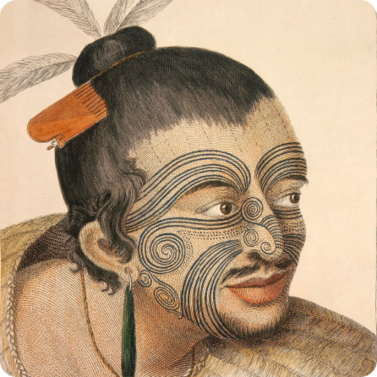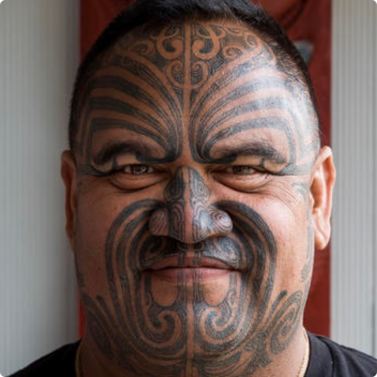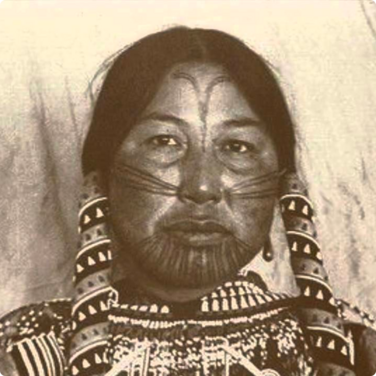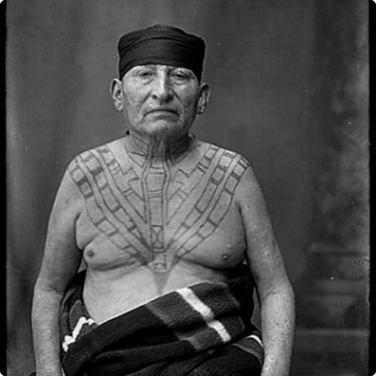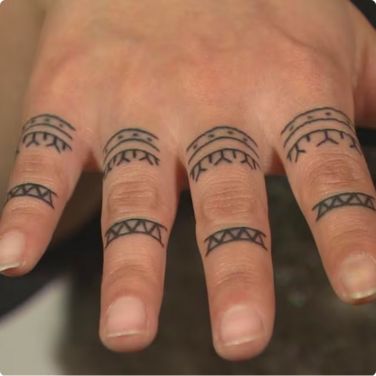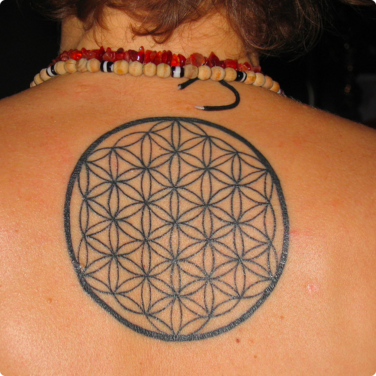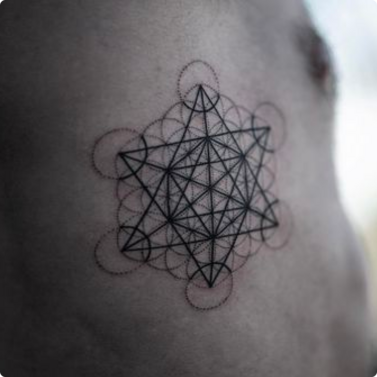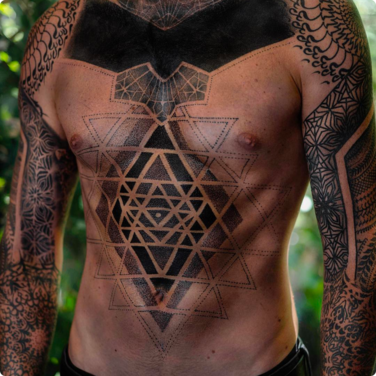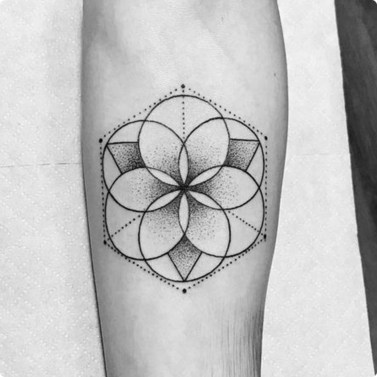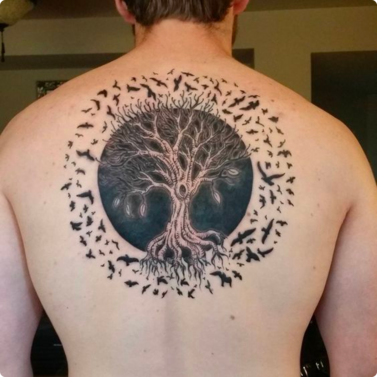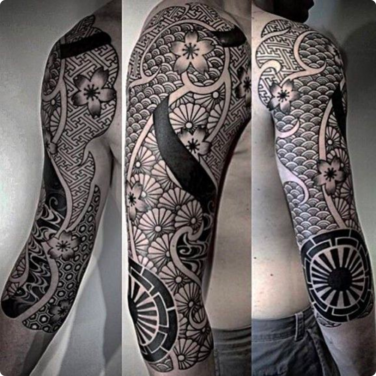Article
Exploring Geometric Tattoos – History, Inspirations, and Artists
Geometric tattoos, a popular tattoo style with precise shapes and intricate patterns, have gained widespread popularity. Learn more about this style's history and key artists.
June 16, 2024
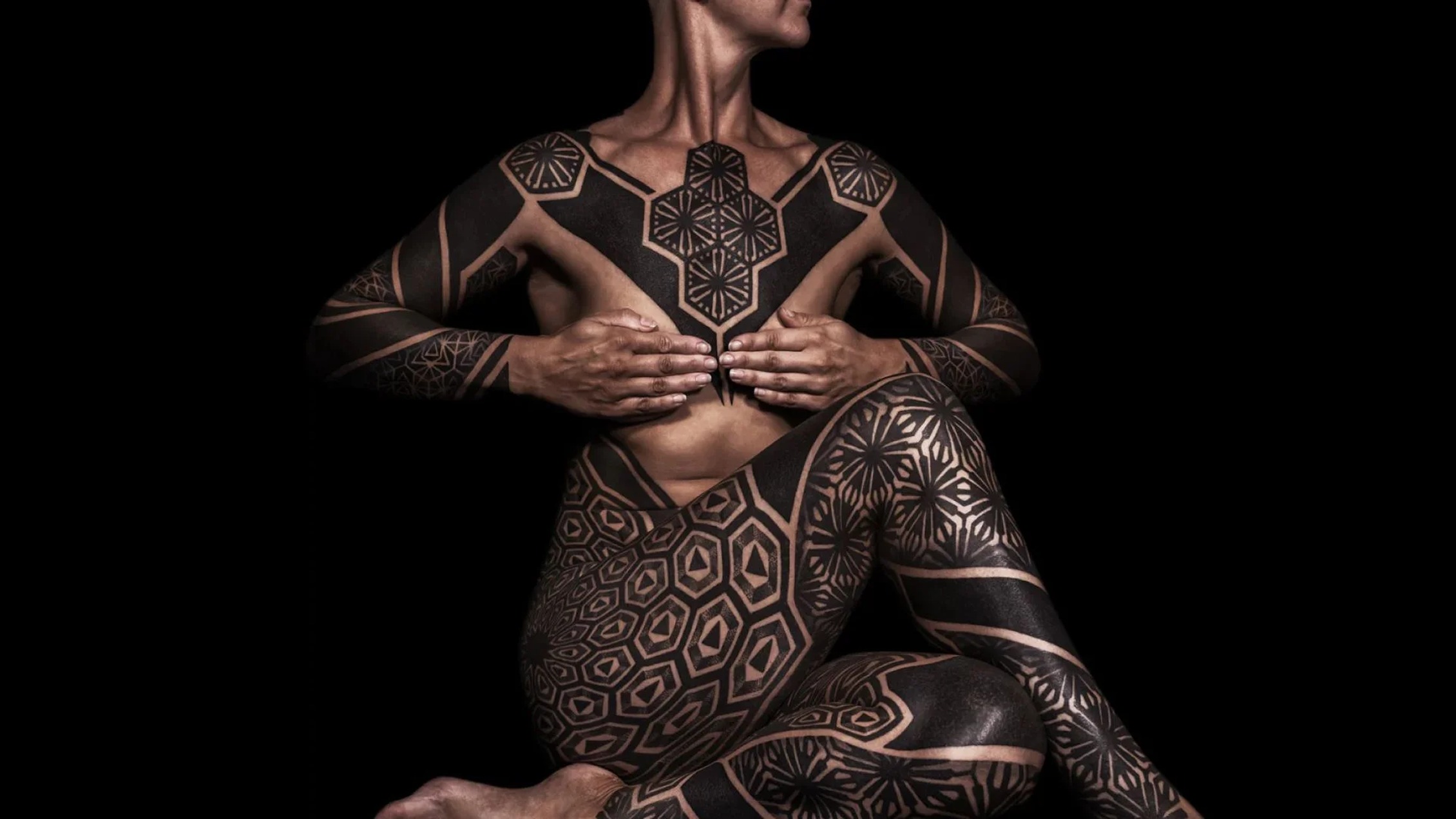
Geometric tattoos, with their precise shapes and intricate patterns, have not only gained widespread popularity but also boasts a rich history woven through centuries. In this article, we dive deep into this style's captivating fusion of history and diverse influences, key figures, and various forms.
It can be argued that geometric tattoos make up a large portion of a broader style of tribal and blackwork tattoos - but for this article we will focus on the geometric work we see by people such as Dillon Forte and Black Symmetry.
Tracing the Origins
Geometric tattoo art traces its roots to ancient civilizations where such designs carried significant cultural and spiritual weight.
In ancient Egypt, geometric shapes weren't just ornamental; they held symbolic value, representing protection and spirituality. Amunet, a priestess of the goddess Hathor and a well-preserved mummy, featured simple geometric patterns across her body.
A similar narrative unfolds across diverse Indigenous tribes globally, from the Maori in New Zealand to Native Americans, each embedding geometric patterns in their tattoo traditions to convey cultural identity and spiritual beliefs. Maori tattoos, also known as Moko, display a person's rank, status, and even lineage.
The contemporary resurgence of geometric tattoos, however, owes much to the experimentation of tattoo artists in the late 20th century – including CO:CREATE Ink founding artists Dillon Forte and Black Symmetry. The bold fusion of traditional tribal elements with modern techniques birthed a distinctive style, propelling geometric tattoos into the spotlight.
Common Themes from Sacred Geometry
Geometric tattoos draw inspiration from a range of influences, creating a harmonious blend of cultural, mathematical, and artistic elements. Sacred geometry, with its mathematical proportions, introduces symbols like the Flower of Life and Metatron's Cube into these designs, offering a unique marriage of mathematical precision and aesthetic finesse.
The Flower of Life is a geometric pattern consisting of evenly-spaced, overlapping circles, forming a symmetrical hexagonal structure. This ancient symbol holds profound spiritual and metaphysical significance across various cultures. Encoded within its intricate design are mathematical proportions believed to represent the fundamental forms of space and time.
Metatron's Cube, a sacred geometric figure formed by connecting the centers of 13 circles, create an intricate two-dimensional pattern. Named after the archangel Metatron, it holds spiritual significance in various mystical traditions. The cube is composed of straight lines, representing the elements of the cosmos and the foundational building blocks of creation. It is believed to contain the keys to understanding the universe's structure.
Various sacred symbols from different cultures and religions may be incorporated, such as the Seed of Life, or the Tree of Life, and Sri Yantra - an ancient Hindu symbol representing the union of masculine and feminine energy, spiritual growth, and the interconnectedness of all things.
Mandalas make up some of the most popular geometric tattoo designs with their Circular, intricate compositions symbolizing wholeness, balance, and the cyclical nature of life. Mandalas often incorporate various geometric patterns.
A multitude of other cultural influences further enrich the tapestry of geometric tattoos. Motifs from tribal art, Celtic knots, and traditional Japanese tattooing intertwine, infusing depth and meaning into the designs. Additionally, contemporary art movements, such as minimalism and abstract art, contribute principles like clean lines and negative space, giving geometric tattoos a modern edge.
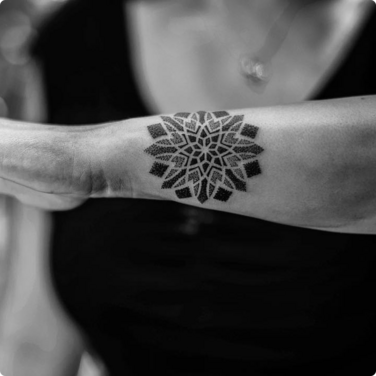
Mandala by Dillon Forte
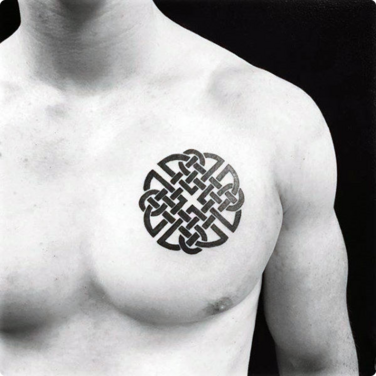
Celtic Knot
Pioneering Visionaries
Among the notable artists in this genre, Dillon Forte and Black Symmetry have gained recognition for their unique contributions to the world of geometric tattoos. Each artist brings a distinctive style, contributing to the evolving landscape of body art.
Dillon Forte, based in Wimberly, Texas, has established himself as a prominent figure in the realm of geometric tattoos. Forte's work is characterized by a harmonious blend of sacred geometry and natural elements. His designs often incorporate intricate patterns inspired by ancient cultures, creating a fusion of modern aesthetics and timeless symbolism.
The precision and detail in Forte's geometric tattoos reflect his dedication to the craft, with a keen eye for symmetry and balance. Forte's geometric designs go beyond mere aesthetic appeal, serving as visual representations of personal journeys and spiritual exploration.
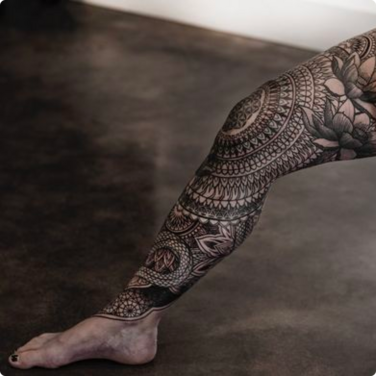
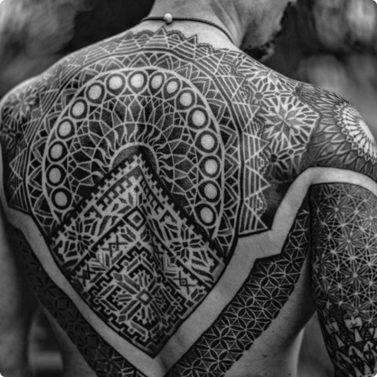
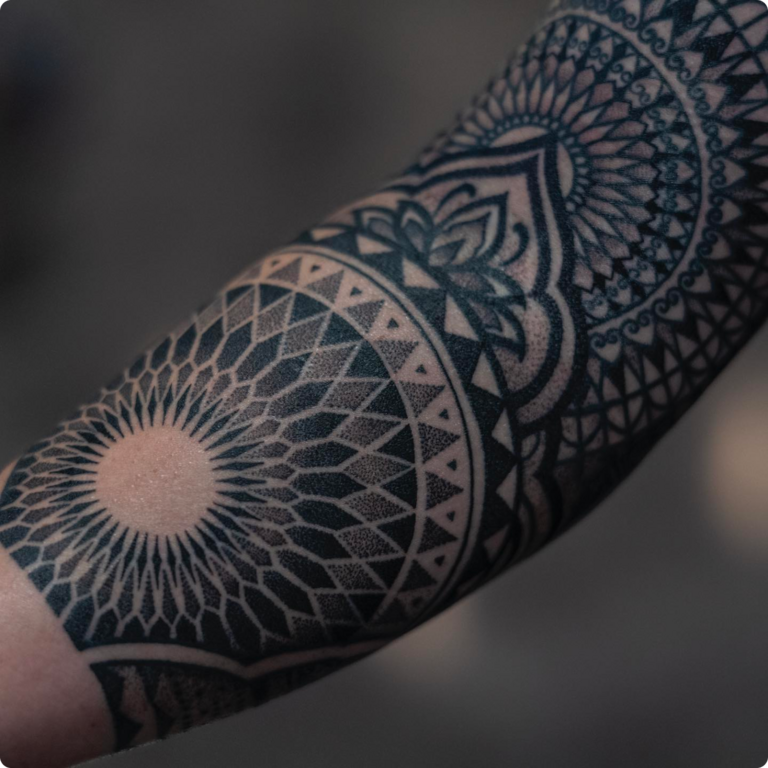
On the other hand, Black Symmetry, an artist known for his geometric tattoo styles, brings a different flavor to the table. Based on the belief that simplicity can be powerful, Black Symmetry's work often revolves around minimalist geometric designs. Clean lines, bold shapes, and a focus on symmetry define his distinctive approach. The simplicity in his designs allows for a timeless and versatile aesthetic, appealing to those who appreciate the elegance of uncomplicated geometry.
Black Symmetry's geometric tattoos often exude a sense of modernity and sophistication. By embracing simplicity, he creates designs that stand the test of time, avoiding trends that may fade over the years. This approach resonates with clients seeking enduring and meaningful tattoo art that remains relevant throughout their lives.

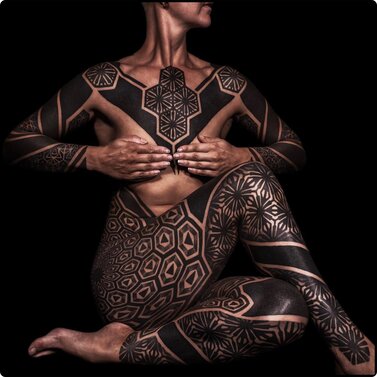
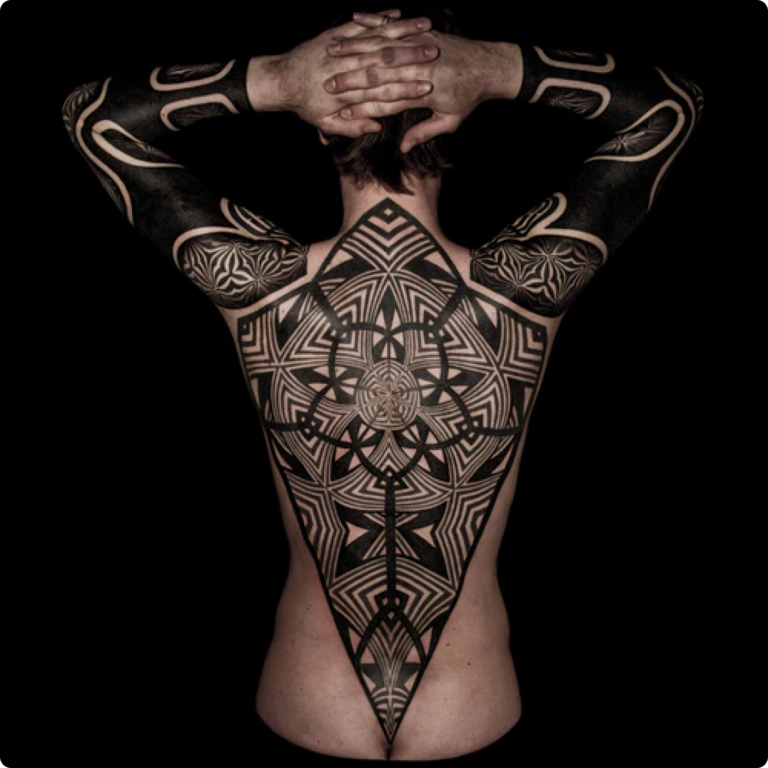
Based in Colorado, Aries Rhysing has gained recognition for his unique approach to tattooing, blending geometric patterns with elements of nature and spirituality. His work often reflects a harmonious balance between precision and organic flow, creating visually stunning and spiritually meaningful tattoos.
Tomas Tomas is a renowned tattoo artist celebrated for his expertise in sacred geometry and esoteric designs. Based in London, Tomas Tomas has elevated the art of tattooing with his intricate and spiritually inspired creations. His work often features geometric precision, drawing inspiration from various cultural and mystical symbols. Tomas Tomas has established himself as a pioneer in the world of contemporary tattoo art, pushing boundaries with his avant-garde approach.
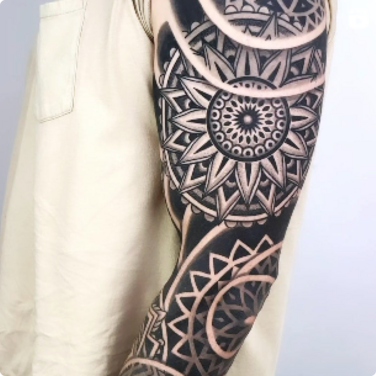
Aries Rhysing
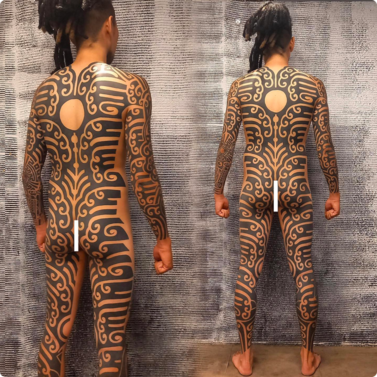
Tomas Tomas
In Conclusion
Geometric tattoos, with their deep historical roots, diverse influences, and the contributions of key figures, stand as a testament to the dynamic nature of tattoo art. From ancient symbolism to contemporary expressions, this style continues to evolve, promising to push the boundaries of creativity and self-expression. As we witness the ongoing legacy of geometric tattoos, it becomes clear that this art form has firmly etched itself into the ever-evolving canvas of body modification.
Discover
Artists
Connect
© 2025 Gesso Labs, Inc.
Privacy PolicyTerms of ServiceReferral TermsGiveaway RulesArtist AddendumAI & LLM
